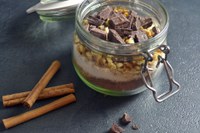Prairie Fare: Take This 5-Question Holiday Food Safety Quiz
(Click an image below to view a high-resolution image that can be downloaded)
By Julie Garden-Robinson, Food and Nutrition Specialist
NDSU Extension Service
Many years ago, I wrote “Easy-Bake Oven” on my Christmas wish list.
I had been perusing the toy section of the thick holiday mail-order catalog that delighted the kids of my generation. We had no online shopping back then.
The delighted girl on the front of the toy box was looking at a cake coming out of the oven. She was beckoning me to join other young bakers.
I really needed that little oven.
As I recall, my practical mom thought that toy ovens, toy sewing machines and other miniature household devices were kind of silly.
“I’ll teach you how to use the real oven,” she said.
Obviously, I did not get to enjoy the tiny cakes baked by a light bulb. Current versions have a different heating element.
My friend had an Easy-Bake oven. The cake was kind of dry, I thought.
That’s how I soothed myself, anyway.
I learned how to bake in our full-size oven under my mother’s watchful eye. We baked at least 25 kinds of cookies and other treats during the holidays.
Most of us have traditional cookies we enjoy, such as Norwegian sandbakkels or German pfeffernusse. At this time of the year, you might be retrieving recipes for nostalgic heritage cookies on yellowed cards written by a relative.
Be sure to try this holiday food safety quiz with updated advice.
- For food safety reasons, what is the first thing to do before beginning to bake your holiday treats?
- Which two ingredients in many cookie recipes could lead to potential food safety issues if you taste the dough without baking? Why?
- Why can companies sell food such as cookie dough ice cream or tubes of cookie dough that can be eaten without baking?
- Should children be encouraged to play with homemade flour-based dough used to make ornaments?
- To what internal temperature should quick breads, scones and other holiday cakes reach during baking?
Here are the brief answers to the questions.
- Be sure to wash your hands thoroughly with soap and water as one of the first things to do. Wash utensils and surfaces that come into contact with raw doughs and batters.
- Raw eggs and flour are two ingredients linked with foodborne illness outbreaks. In some cases, hospitalizations result. Eggs could be contaminated with salmonella bacteria. Each year, about 30 people die as a result of eating undercooked contaminated eggs.
Flour could contain E. coli, including the dangerous shiga-toxin producing E. coli O157:H7. Flour is a “raw food” milled from grain that is processed without heating. Heating usually is the “kill step” for bacteria. Enjoy eggs and flour, but be sure they are in cooked or baked foods.
- Edible cookie dough is made using treated flour and pasteurized eggs. If you buy ready-made dough, be sure to read the baking instructions on the package. Some have warnings about not eating without baking, and some doughs are edible right out of the package. Manufacturers do not want you to get sick.
- Food safety experts say “no.” Kids like to taste things. Do not let children play with or eat flour-containing dough that is used for crafts. See https://www.foodsafety.gov/blog/say-no-raw-dough for more information.
- The Home Baking Institute recommends baking most cakes to an internal temperature of 200 to 209 degrees F and testing with both a toothpick and a food thermometer. Retrieve cheesecakes from the oven when they reach 150 degrees F. The temperature will continue to rise and your cheesecake will retain its quality.
See the Home Baking Association website at https://www.homebaking.org/baking-food-safety/ to learn about food safety and baking. Internal temperature recommendations are available for a variety of baking goods.
Instead of a recipe, this week I have some gift mix recipes I invite you to explore. Each publication describes how to layer a jar with the ingredients, along with the recipe card to attach to your gift.
Visit www.ag.ndsu.edu/food and click on “Food Preparation” then “Quick Mixes.” Be sure to click on “Download PDF” for a printable version.
On the website, you will find “Mix It Up” that includes a delicious and festive “Cranberry-Oatmeal Cookie Mix.” My students at the time made the recipe repeatedly to perfect it. It was fine the first time, but they liked the cookies. This publication also includes Chili Mix, Cornbread Mix and Friendship Soup.
“Beverage Mixes in a Jar” includes Double Chocolate Peppermint Candy Hot Cocoa Mix, Spiced Tea Mix and Mint Candy Coffee Mix.
“Give the Gift of Joy with a Quick Bread Mix” includes Herb Quick Bread, Snickerdoodle Muffins, Cherry-Chocolate Scones and Peanut Butter Bread.
(Julie Garden-Robinson, Ph.D., R.D., L.R.D., is a North Dakota State University Extension food and nutrition specialist and professor in the Department of Health, Nutrition and Exercise Sciences. Follow her on Twitter @jgardenrobinson)
NDSU Agriculture Communication – Dec. 9, 2021
Source: Julie Garden-Robinson, 701-231-7187, julie.garden-robinson@ndsu.edu
Editor: Kristin Harner, 701-231-7875, kristin.harner@ndsu.edu




